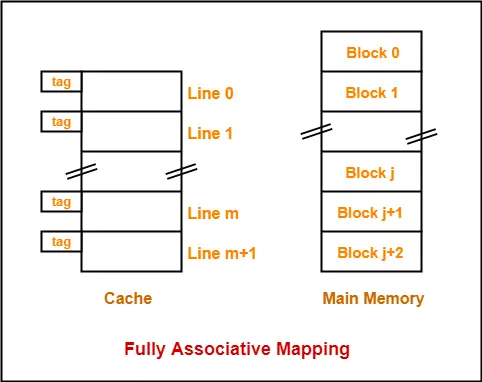Fully Associative Mapping-
Before you go through this article, make sure that you have gone through the previous article on Cache Mapping.
In fully associative mapping,
- A block of main memory can be mapped to any freely available cache line.
- This makes fully associative mapping more flexible than direct mapping.
- A replacement algorithm is needed to replace a block if the cache is full.
In this article, we will discuss practice problems based on fully associative mapping.
Also Read- Practice Problems On Direct Mapping
PRACTICE PROBLEMS BASED ON FULLY ASSOCIATIVE MAPPING-
Problem-01:
Consider a fully associative mapped cache of size 16 KB with block size 256 bytes. The size of main memory is 128 KB. Find-
- Number of bits in tag
- Tag directory size
Solution-
Given-
- Cache memory size = 16 KB
- Block size = Frame size = Line size = 256 bytes
- Main memory size = 128 KB
We consider that the memory is byte addressable.
Number of Bits in Physical Address-
We have,
Size of main memory
= 128 KB
= 217 bytes
Thus, Number of bits in physical address = 17 bits

Number of Bits in Block Offset-
We have,
Block size
= 256 bytes
= 28 bytes
Thus, Number of bits in block offset = 8 bits

Number of Bits in Tag-
Number of bits in tag
= Number of bits in physical address – Number of bits in block offset
= 17 bits – 8 bits
= 9 bits
Thus, Number of bits in tag = 9 bits

Number of Lines in Cache-
Total number of lines in cache
= Cache size / Line size
= 16 KB / 256 bytes
= 214 bytes / 28 bytes
= 26 lines
Tag Directory Size-
Tag directory size
= Number of tags x Tag size
= Number of lines in cache x Number of bits in tag
= 26 x 9 bits
= 576 bits
= 72 bytes
Thus, size of tag directory = 72 bytes
Problem-02:
Consider a fully associative mapped cache of size 512 KB with block size 1 KB. There are 17 bits in the tag. Find-
- Size of main memory
- Tag directory size
Solution-
Given-
- Cache memory size = 512 KB
- Block size = Frame size = Line size = 1 KB
- Number of bits in tag = 17 bits
We consider that the memory is byte addressable.
Number of Bits in Block Offset-
We have,
Block size
= 1 KB
= 210 bytes
Thus, Number of bits in block offset = 10 bits

Number of Bits in Physical Address-
Number of bits in physical address
= Number of bits in tag + Number of bits in block offset
= 17 bits + 10 bits
= 27 bits
Thus, Number of bits in physical address = 27 bits

Size of Main Memory-
We have,
Number of bits in physical address = 27 bits
Thus, Size of main memory
= 227 bytes
= 128 MB
Number of Lines in Cache-
Total number of lines in cache
= Cache size / Line size
= 512 KB / 1 KB
= 512 lines
= 29 lines
Tag Directory Size-
Tag directory size
= Number of tags x Tag size
= Number of lines in cache x Number of bits in tag
= 29 x 17 bits
= 8704 bits
= 1088 bytes
Thus, size of tag directory = 1088 bytes
Also Read- Practice Problems On Set Associative Mapping
Problem-03:
Consider a fully associative mapped cache with block size 4 KB. The size of main memory is 16 GB. Find the number of bits in tag.
Solution-
Given-
- Block size = Frame size = Line size = 4 KB
- Size of main memory = 16 GB
We consider that the memory is byte addressable.
Number of Bits in Physical Address-
We have,
Size of main memory
= 16 GB
= 234 bytes
Thus, Number of bits in physical address = 34 bits

Number of Bits in Block Offset-
We have,
Block size
= 4 KB
= 212 bytes
Thus, Number of bits in block offset = 12 bits

Number of Bits in Tag-
Number of bits in tag
= Number of bits in physical address – Number of bits in block offset
= 34 bits – 12 bits
= 22 bits
Thus, Number of bits in tag = 22 bits

To watch video solutions and practice more problems,
Next Article- Set Associative Mapping | Implementation & Formulas
Get more notes and other study material of Computer Organization and Architecture.
Watch video lectures by visiting our YouTube channel LearnVidFun.

